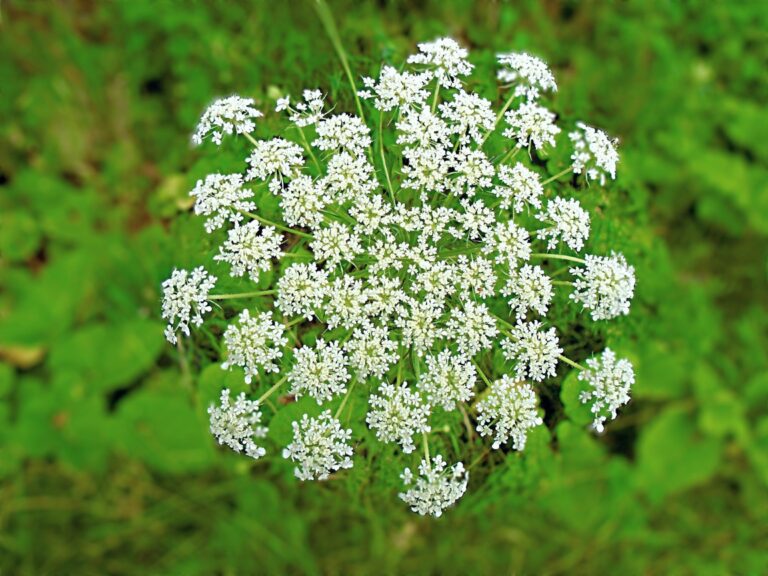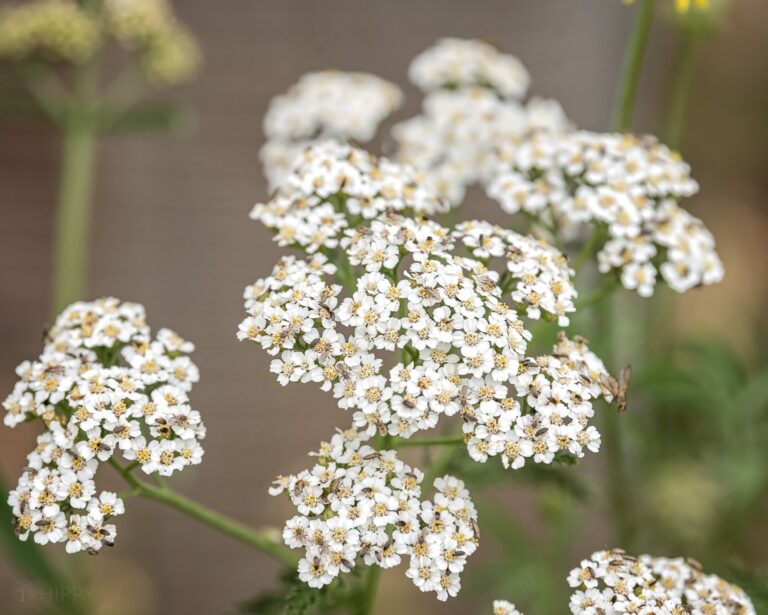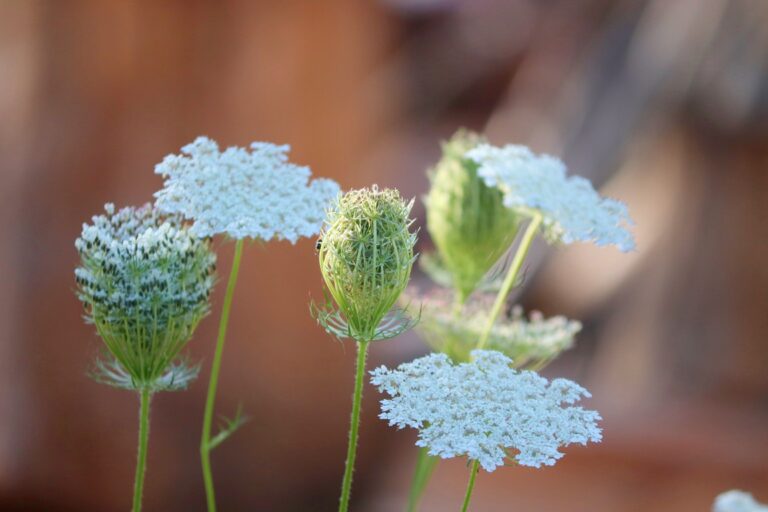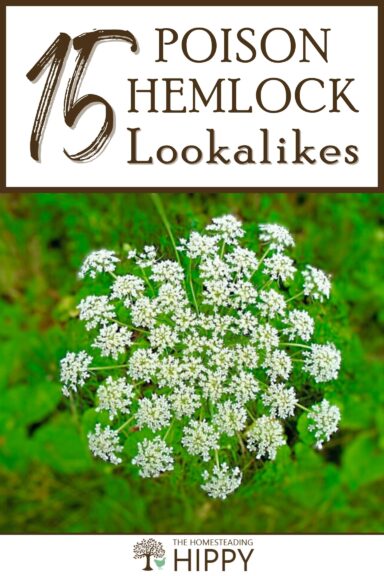Poison hemlock is one of the most toxic plants found in North America, and also one of the most dangerous that can be found the world over.

It grows readily in many areas, naturalizes quickly and is completely uncontrolled because there really isn’t anything that will eat it.
The plant is so toxic that ingesting any part of it, even a tiny amount, might result in death! The toxin can even be absorbed through the skin or inhaled if the plant is cut, crushed, or mowed over.
Also, poison hemlock has many lookalikes, some of them dangerous, some not, but the fact that it looks like so many innocent plants only increases the likelihood of a bad encounter.
You’ll definitely need to know what this increasingly common and deadly plant looks like, and also the imposters. I’ll tell you about no less than 15 of them below…
What Does Poison Hemlock Look Like?
Poison hemlock is an extremely toxic biennial, herbaceous plant. You may know it by its hollow stalks which are typically streaked or splotched with reddish or purple markings- a nearly certain giveaway that you’re dealing with the genuine article.
The leaves are triangular, lace-like, and sprout from multiple branching stands along its length.
The leaves themselves are hairless and compound, and grow opposite on the stems. At the end of each stem, when the plant is in bloom, you’ll find clusters of pretty, delicate and tiny flowers growing in umbrella-shaped clusters called umbels.
Each flower, though tiny, has five distinct petals and among them you’ll sometimes find small green fruits with irregular ridges.
Each fruit has extremely poisonous seeds which resemble fennel seeds. It blooms in the summertime, typically from May to August.
Hemlock is a tall plant, usually topping out around 8 feet on average, but it might grow as high as 10 feet. Notably, it grows well in many places.
It is a regular sight along trails and bike paths, near the edges of woodlines, in damp, well-drained areas, and along roadsides. When it is well-established it can grow very densely!
Lastly, you can know poison hemlock by the smell; if broken, crushed or trampled, it emits a nasty foul-smelling odor that is usually described as musty.
Poison Hemlock Lookalikes
1. Water Hemlock
Water hemlock is a close and deadly cousin to poison deadlock, described above. But unlike it, water hemlock is a perennial and you’re more likely to find it in wet areas than you are its larger lookalike.
It doesn’t grow quite as tall, but it’s got the same hollow stems with purple stripes or blotches on it.
Also very much like poison hemlock, it has tiny, attractive white flowers that grow in dense clusters called umbels.
Aside from size, the two plants look very close and both are extremely toxic. Avoid at all costs!

2. Yarrow
Yarrow is a beneficial plant that has enjoyed a storied reputation as an edible, and also as a fixture in indigenous tribal healthcare around the world.
Another hardy perennial, this one has a wide growth habit somewhat like hemlock, and feathery leaves that might be mistaken for hemlock at first glance.
However, unlike hemlock’s consistently white blooms yarrow may produce off-white or pinkish flowers, though some can be white just the same.
Yarrow also typically blooms a little later in the summer and longer into the season, usually from June to September and is much shorter than hemlock at only 1 to 3 feet tall.
3. Angelica
Another tall and beautiful plant that is crowned by dense groups of tiny white flowers, you might readily confuse Angelica for poison hemlock on account of the flowers alone.
It even blooms in June, often in early June, meaning it is usually coming to flower right about the same time as hemlock.
More confusing still, the stems are also a vivid eggplant-purple color, which might cause you to doubt your assessment.
The main difference is that the stems of Angelica are a solid, even purple except for small patches of green on the ribs and ridges.
This is in stark contrast to the patchy appearance of poison hemlock. The leaves, likewise, are finely toothed and distinct from poison hemlock.
4. Cow Parsnip
Another toxic lookalike, cow parsnip has a similar growth habit to poison hemlock and likewise grows quite tall, maxing out at around 10 feet.
Once more, it has spreading clumps of small white flowers atop green stems lined with fine, delicate hairs.
You should note that the stems of cow parsnip are a solid, even green color, not streaked or spotted with purple or red.
The leaves are also highly distinct from poison hemlock, being deeply lobed and large. One possible point of confusion is that the stems are indeed hollow like poison hemlock’s.
Although not as dangerous, the sap contained in a mature cow parsnip plant can cause photodermatitis, so keep your distance and use gloves when handling it or else you’ll burn severely in the sun.
5. Wild Parsnip
Another parsnip plant, and still another one that is dangerous to handle by the uninitiated. Wild parsnip has yellowish or dingy-looking flowers and only grows to a height of 5 feet or perhaps just a little bit more.
This means it’s quite a bit smaller than a mature poison hemlock plant, but that won’t help you if you’re dealing with younger plants.
The leaves grow opposite on the stems, and have few, coarse teeth along their length. The stems of the plant are grooved, but hairless.
The color, shape, and stems of wild parsnip will give it away if you know what to look for and compare it to poison hemlock.
Be advised that this is another phototoxic plant, so don’t get any sap on your skin and be sure to protect yourself from sunlight if you are exposed.
6. Water Parsnip
How many parsnip hemlock lookalikes are there!? This hemlock imitator grows in or very near the water.
It even has inverted umbrella-shaped clusters of tiny white flowers, and that means most people that know enough about poison- and water hemlock will run from this one on sight.
It really is a dead ringer! Luckily, you don’t have to, because it is non-toxic.
You can identify water parsnip because it grows much lower to the ground compared to poison hemlock and also because its leaves are pinnately divided with each having toothed leaflet, though the leaf shape and arrangement depending on how close to (or in) the water it is growing.
Check the stem; it won’t have any purple patches.
7. Common Ragweed
The constant bane of allergy sufferers, common ragweed may be mistaken for poison hemlock when it isn’t in bloom.
The biggest giveaway, when it is in bloom, is the fact that the flowers are always a pale green or distinctly yellow color, not the pure, funereal white of poison hemlock.
It also grows short, usually, maxing out around 3 feet. Nowhere near as big as poison hemlock. It is an annual, not a biennial, and it grows with a rough-textured and hairy stem.
The leaves are fern-like which can lead to confusion, but deeply lobed. Not harmful to handle unless you have allergies!
8. Elderberry
A popular ornamental and also producer of delicious berries (so long as they’re cooked properly!), elderberry plants can be found growing as shrubs, trees or sometimes even as vines.
The biggest giveaway when the plants are productive is the shape of the fruit, with elderberry producing large purple-black berries from its clusters of white or cream-colored flowers.
The leaves are also pretty different from poison hemlock, growing opposite on each stem with a distinct, sharply-pointed lance shape.
The stems themselves look woody, like a typical tree’s bark, instead of the green and purple blotched stem of hemlock.
9. Giant Hogweed
Yet another devastatingly toxic and highly dangerous poison hemlock lookalike, the only good news is that the two look so similar you’d be wise to stay away from either one if you know what’s good for you!
And you should, because this hellish weed produces sap that will blister you severely if exposed to sunlight.
Giant hogweed is also a humongous plant, topping out at more than 15 feet tall. The leaves themselves are immense, and sometimes more than 5 feet across in the case of largest specimens.
Just like poison hemlock, giant hogweed is topped with equally giant umbels of bright white, attractive flowers.
Also just like poison hemlock, the stems are green with dark purple splotches with hairs growing along the length.
But note that the stems of giant hogweed have sharp ridges or edges, in a square pattern. Both of these plants are major trouble, avoid them!

10. Queen Anne’s Lace (Wild Carrot)
More than any other plant on our list, it is Queen Anne’s Lace that is most likely to result in disaster for you if confused for poison hemlock.
That’s because Queen Anne’s Lace is nothing but a simple wild carrot, and is a popular edible for foragers and survivors alike.
The leaves are narrow and very lacy (hence the name), and it blooms from June to September. It also has hairy stems with vertical veins running along the length.
And, of course, like so many other imitators, it’s crowned with pretty and appealing white flowers.
The only major difference, aside from the leaves, is the fact that Queen Anne’s Lace doesn’t have purple blotches on its stem, and only grows to a maximum height of about 3 feet at most.
But if you mistake any part of this edible plant for poison hemlock, and eat it, that could be the end for you. Pay attention to your nose, too: this one smells like a carrot, not the nastiness of hemlock.
11. Tall Meadow Rue
Tall Meadow Rue is another pretty, tall plant, just like the name suggests, and one with blue-green leaves that you might mistake for poison hemlock because of their outline and color.
But look closer and you’ll see that the leaves of a tall meadow rue are not as serrated or as divided as the leaves of hemlock.
The off-white or pale green flowers of tall meadow rue also grow in clumps, not umbels like poison hemlock or those of many other plants on this list.
Adding to the potential confusion, the stems of tall meadow rue are various shades of solid purple. It isn’t speckled like hemlock, though.
12. Fool’s Parsley
This toxic parsley plant is an annual with a smooth, hollow stem just like poison hemlock, though the leaves look quite a bit different.
Fool’s parsley has thinly divided leaves, giving them a smaller overall appearance for each leaflet.
But, even though it doesn’t grow as big as a mature and well-established hemlock plant, fool’s parsley still sprouts highly similar clusters of white flowers that radiate around a central stem.
It’s also poisonous, though not nearly to the same degree as hemlock.
13. Wild Fennel
Wild fennel is a beloved kitchen herb enjoyed around the world for its seeds and leaves which can impart a licorice-like flavor to dishes.
The overall growth pattern of wild fennel might be confused for poison hemlock when both plants are smaller, but poison hemlock gets much larger overall.
Also, look closely at the stems and leaves of wild fennel and you can spot some immediate differences: wild fennel leaves are feathery fronds, and tightly divided.
The growth pattern of the flowers is similar, with that distinctive “flat top” arrangement for each cluster, but the flowers themselves are yellow, not white.
And again, check the fragrance: if you smell licorice or anise, it isn’t hemlock.
14. Goutweed
Goutweed is an edible plant that looks very similar to both poison hemlock and Queen Anne’s Lace.
But you can easily tell apart mature plants because gout weed grows much lower overall, unlike the huge and sometimes towering poison hemlock.
But for young plants, you can’t depend on that: The flowers – size, shape and arrangement – are also quite similar.
But inspect the leaves closely: goutweed has toothed compound leaves that don’t have the same appearance of poison hemlock, and aren’t triangular in shape overall.
Also, the fragrance here can tell the difference, but be cautious: broken hemlock stinks but gout weed doesn’t.
15. Toothpick Plant
An invasive plant that has long ago escaped its native Mediterranean range to grow naturalized all over the world, the toothpick plant might only be confused for poison hemlock due to its overall growth habit.
The stems and leaves are however very different: you will easily see the stems of the toothpick plant are extremely straight and rigid, with leaves that are thin and grass-like, not divided in the same way as poison hemlock’s.
But do take care: if you aren’t paying close attention the white flowers of the toothpick plant, which grow in tiny, precious groups atop those tall straight stems, might be confused for those of poison hemlock!

Tim is a farm boy with vast experience on homesteads, and with survival and prepping. He lives a self-reliant lifestyle along with his aging mother in a quiet and very conservative little town in Ohio. He teaches folks about security, prepping and self-sufficiency not just through his witty writing, but also in person.
Find out more about Tim and the rest of the crew here.
